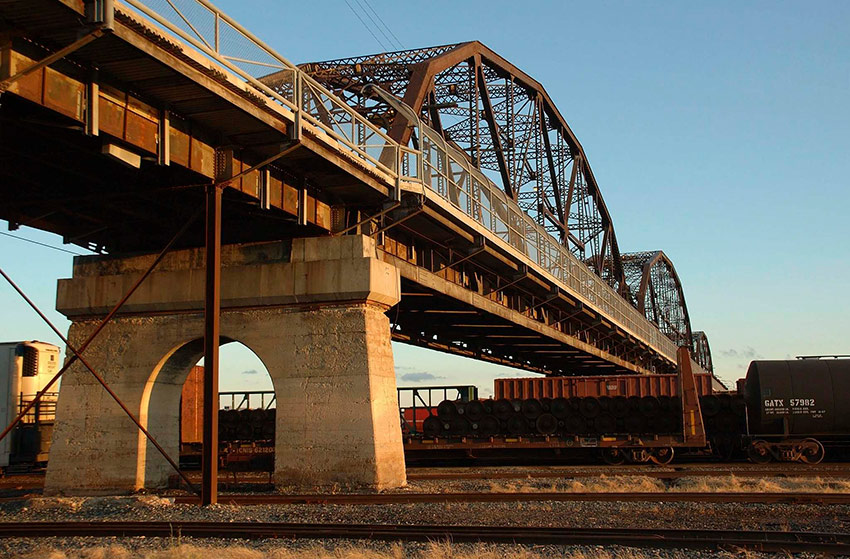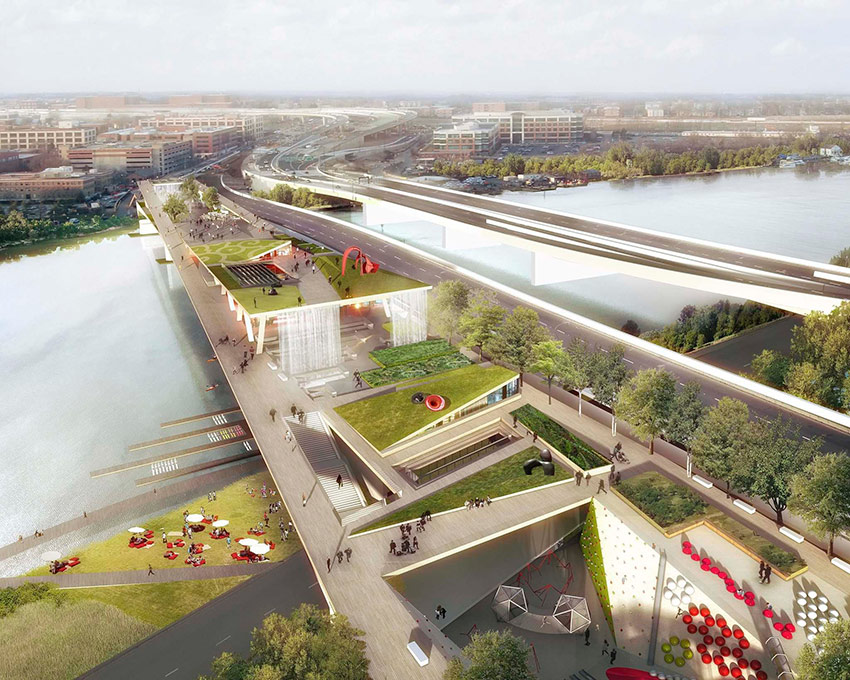
By Brent Bellamy, Creative Director and Architect
Republished with permission courtesy of the Winnipeg Free Press.
The three graceful arches of the old Arlington Bridge have cast their curving shadows on Winnipeg’s central rail yards for 105 years. It’s become a quintessentially Winnipeg experience to ascend the bridge’s steep ramp and cross its narrow deck as the rhythm of steel girders ticks by.

Image: Brent Bellamy
Winnipeg could follow the lead of other cities and turn the old Arlington Bridge (above) into an innovative public space. One such city is Washington, D.C., which reimagined its decommissioned 11th Street Bridge (left) as a multi-functional community space.
The sweeping panorama — a rarity in a flat city — lays out below, with rows of trains vanishing into the horizon, the downtown skyline rising over an elm tree canopy beyond.
Few bridges provide an experience as unique as Arlington, and even fewer provide a better story. The prevailing legend explains that the ramps are so steep because the bridge, built in England, was actually designed to span the Nile River. When a contract fell through, the structure was offered to Winnipeg on the cheap and shoehorned into the site. Built specifically to run streetcars to the North End, the steep ramps prevented a single trolley from ever crossing. Image: OMA+OLIN Architects
Image: OMA+OLIN Architects
The decommissioned 11th Street Bridge in Washington, D.C,. has been reimagined as a multi-functional community space.
With all its quirks, calls for the bridge’s replacement go back more than 70 years. This month, the City of Winnipeg will begin public consultation for the design of a new $300-million bridge, with more lanes, better emergency vehicle and transit access and less-steep ramps for pedestrians and cyclists. Public art will attempt to make the modern roadway more visually appealing.
The starting point for public consultation assumes the old bridge will be demolished, specifically identifying that it cannot be repurposed to another use. The steep ramps and aging structure are provided as anecdotal reasons for this decision, but no formal study identifying the criteria used in this assessment has been made public.
It is undoubtedly easiest to simply demolish the Arlington Bridge and build a new concrete roadway, but without thoroughly investigating its reuse, are we missing an important opportunity to create something special for our city?
Cities across North America have demonstrated that with a little imagination, bridges at the end of their service lives can be reborn as important community spaces and even tourist attractions that breathe new life into inner-city neighbourhoods.
New York’s High Line established the model in 2009, transforming an abandoned elevated rail corridor into a 2.5-kilometre-long urban park. Other cities have successfully followed suit. Chicago, Minneapolis and even Chattanooga, Tenn., have all transformed old bridges into dynamic public spaces.
Most closely related to the Arlington Bridge is 11th Street Bridge in Washington, D.C., where a modern span was constructed next to a decommissioned older bridge that was slated to be demolished. Community groups rallied together to propose an ambitious project; using the old structure to create a 300-metre-long, multi-functional community space, connecting two neighbourhoods and new public parks on either side.
A goal was set to create a place of pride that will stitch together two long-divided neighbourhoods, establishing a community node and regional destination that acts as an economic catalyst by providing employment within the park and drawing visitors to the community and its surrounding commercial streets.
An international design competition was held and won by the Office for Metropolitan Architecture, with a dramatic scheme of terraced lawns, parks and playgrounds, as well as a café, amphitheatre, education centre and space for community agriculture gardens and neighbourhood vendors.
Through a public fundraising campaign and support from the civic government, much of the US$50-million construction cost has been raised and the park is slated to open in 2019. When complete, a simple roadway will be reborn as a cultural and social amenity for the entire city, bringing new opportunity to a struggling neighbourhood.
Ambitious community-led projects such as the 11th Street Bridge should inspire us in Winnipeg to dream and to be creative when it comes to our infrastructure investments. We should ask ourselves, is the old Arlington Bridge an opportunity to create something that is a similar source of pride, recreation and economic growth? The reuse of the old Disraeli Bridge piers to support a new active-transportation corridor is an excellent precedent for this type of creative thinking.
The Arlington Bridge and its importance to the surrounding communities deserve a unique effort to investigate its reuse within the current public consultation exercise. There are many creative ideas to be explored that might use the old bridge in new ways without the structural requirements of vehicular traffic.
With the new span slated to be built beside the old, is there an opportunity to connect the two in the middle? Maybe we demolish all but the centre arched spans, transforming them into a dramatic public space for the new bridge. Could the money earmarked for public art be redirected to develop the old bridge into a public space accessed from the new, with its lower slope ramps and bike lanes? Could the old bridge become the active transportation component of the new, with new ramps built only for cyclists and pedestrians? Could the ramps become landscaped terraces? Should we hold a design competition to invite the world to dream about the possibilities?
Imagine public gardens, vendors, gathering and performance spaces on the old bridge, connecting parkland and recreational pathways that reach into the surrounding communities.
Imagine watching the sunset between those steel arches, surrounded by trees and grasses, an injection of nature uniquely floating over an industrial site. Imagine a children’s playground and interpretive centre, teaching future generations about our city’s history on a piece of its history. Imagine a public place that improves quality of life in the inner city and is powerful enough to draw together residents from every neighbourhood.
Just imagine, Winnipeg.
Brent Bellamy is chairman of CentreVenture’s board and the creative director at Number Ten Architectural Group.
bbellamy@numberten.com